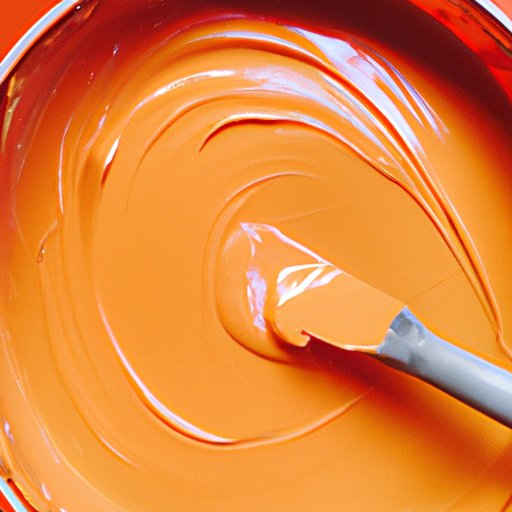
Introduction
Are you an artist or creative who frequently works with paints? If yes, you know how important it is to have access to a wide range of colors to create vibrant and unique pieces. One color that can add depth and warmth to your paintings is orange. While you can buy orange paint, it’s also easy and cheaper to make it at home. In this article, we will discuss how to make orange paint, different techniques to create your own hues, tips and tricks to mix pigments, and recipes for homemade paint.
Step-by-Step Guide on How to Make Vibrant Orange Paint with Just 3 Ingredients
To make vibrant orange paint, you only need three colors: red, yellow, and white. You can use any type of paint with these hues, such as acrylics, watercolors, or oils. Here’s a step-by-step guide to making orange paint:
Step 1: Squeeze out a small amount of red and yellow paint on your palette. You can use equal amounts of both colors to make a bright orange, but you can also adjust the ratio to make darker or lighter hues.
Step 2: Mix the red and yellow paint together using a brush or palette knife. Start with a small amount of paint, and add more as needed until you achieve the desired hue. Remember, a little goes a long way!
Step 3: Add white paint to the orange mix to create a more opaque and lighter tone. Use small amounts of white paint gradually until you achieve the shade you desire.
Step 4: Mix well and test the color on a piece of paper or canvas. If the color is too dark, add more white, and if it’s too light, add more red and yellow.
By following these simple steps, you can make orange paint with just three ingredients.

DIY Orange Paint: Simple Techniques to Create Your Own Hues and Tones
Creating your own shades and tones of orange is easy and fun. There are several ways to do it.
One technique involves mixing complementary colors with red and yellow. For example, adding a little blue paint to the mix can create a more muted and earthy tone of orange. Mixing orange with green can create a lively and bright hue. Experimenting with different complementary colors can lead to beautiful and unique shades of orange.
Another technique is to mix different values of orange. By adding tiny amounts of black to orange paint, you can create darker and richer hues. Conversely, adding a little white paint can create a lighter and more pastel hue of orange. This technique is called tinting and shading.
The Art of Making Orange Paint: Tips and Tricks for Mixing Pigments
To make vibrant and high-quality orange paint, it’s essential to understand color theory. Complementary colors, for example, are opposites on the color wheel. Mixing them in the right proportion can result in a hue that’s more harmonious and balanced.
Here are some tips and tricks to keep in mind when mixing pigments to make orange paint:
– When mixing red, yellow, and white, start with the lighter hues and move to darker hues. This technique will help you avoid adding too much pigment to your mix.
– Use small amounts of paint when making orange. Orange can quickly become too intense or too dark, making it harder to lighten or tone down.
– Mix complementary colors in proportion to achieve the hue and tone you desire. For instance, a small amount of blue added to orange can create a muted tone while more blues can create a dark and rich tone.
Creating Custom Orange Paint: Combining Colors and Experimenting with Shades
The benefits of experimenting with different colors to create custom tones and shades of orange are bountiful. As stated earlier, mixing complementary colors with orange can result in unique hues. Additionally, mixing different colors in varying proportions to orange can create similar but slightly different shades.
To create a more taupe-like orange, try adding some burnt sienna to the paint mix. For a more vibrant hue, mix with some cadmium yellow. By exploring different mixtures, you can create endless variations of orange paint.
From Scratch: Homemade Orange Paint Recipes for Artists and Creatives
Making paint from scratch offers endless possibilities to artists and creatives. By knowing the required ingredients, you can create vivid colors that have greater translucency and clarity than store-bought paints.
Here are some recipes to make homemade orange paint using natural ingredients:
– Recipe 1: Mix one tablespoon of turmeric powder with two tablespoons of flour in a bowl. Then, add water to the mixture slowly, stirring constantly until it forms thick paint. This recipe will produce a bright, earthy-colored paint.
– Recipe 2: Mix two tablespoons of juice from boiled carrots with four tablespoons of white flour. Stir until you form a paste or a thick paint with the desired orange tone.
Getting the Perfect Orange: Factors Affecting the Color and Quality of Your Paint
Several external factors can affect the color and quality of your orange paint. Lighting, humidity, and temperature can affect how vibrant your paint is and how it dries. For example, a piece of canvas painted in a shaded space can appear entirely different from a canvas that has been painted under direct sunlight. Different temperatures affect how fast or slow paint dries, which may alter your painting’s overall texture.
To counter these factors, ensure that you paint in a room with consistent and adequate lighting. That will help regulate the hue and tone of your orange paint. Consider investing in a dehumidifier to ensure that the humidity in your room remains consistent or turning up the air conditioning.
Make Your Paint Stand Out: Enhancing Orange Pigments with Additives and Mediums
Additives and mediums can improve the texture, consistency, and vibrancy of your orange paint. For instance, some common mediums include gels, pastes, and liquids that can change the thickness of the paint.
Here are some other ways to experiment with additives and mediums to enhance the texture and vibrancy of orange pigments:
– Add a gloss medium to your orange paint for a wet or glossy finish.
– Use texture pastes to create textures and patterns on your canvas.
– Experiment with glaze mediums, which can give your paint a transparent finish.
Conclusion
Making orange paint can be enjoyable and easy, and experimenting with different techniques, hues, and tones is a great way to unleash your creativity. Remember to consider color theory when mixing pigments, use additives to enhance your paint’s vibrancy and texture, and try out different methods for creating custom orange shades. By following the tips and techniques shared in this article, you’ll be able to make orange paint like a pro and use it for your artistic projects with confidence.





